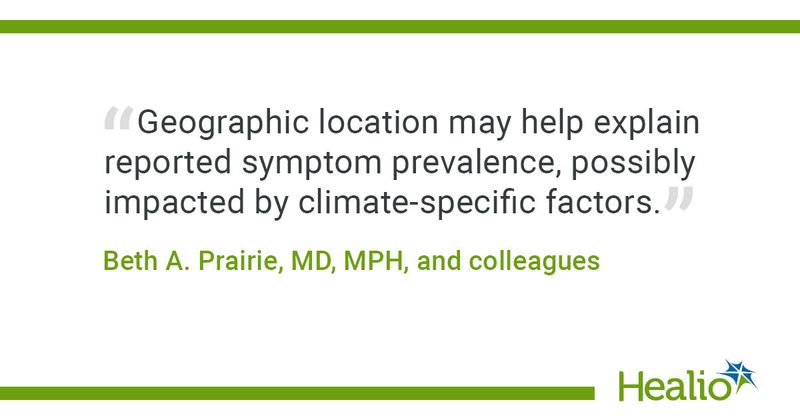Sexual dysfunction risk differs by ethnicity, geography for menopausal women
A group of Hispanic women from Texas reported more sexual dysfunction symptoms compared with non-Hispanic women, and menopausal women in Texas noted fewer sexual dysfunction symptoms than those from Arizona, according to study data.
“In a group of menopausal women from two distinct geographic and socioeconomic backgrounds, differences were seen in self-reported menopausal symptom prevalence and self-reported sexual problems,” Beth A. Prairie, MD, MPH, chief medical officer at West Penn Hospital, Alleghany Health Network in Pittsburgh, and colleagues wrote in a study published in Menopause. “Notably, most of the women surveyed were at risk for sexual dysfunction, and the degree of dysfunction appeared to be greater in the Hispanic participants from Texas. Geographic location may help explain reported symptom prevalence, possibly impacted by climate-specific factors.”

Researchers surveyed women aged 40 to 60 years who spoke English or Spanish. Mail, in-person and electronic surveys were distributed in west Texas in 2012 and Scottsdale, Arizona in 2016, with 1,000 initial surveys sent at each site. Participants provided demographic data, including age, socioeconomic status, ethnicity, language preference, household information and insurance status. The Green Climacteric Scale (GCS) was used to assess menopausal symptoms, with a higher score representing more symptoms. The Female Sexual Function Index (FSFI) was used to determine sexual dysfunction risk, with a score of less than 26.55 being consistent with a risk for female sexual dysfunction. Researchers compared GCS and FSFI scores between Hispanic and non-Hispanic women in Texas and between non-Hispanic women in Arizona and Texas. Participants who were not sexually active in the 4 weeks prior to the survey were excluded from FSFI analysis.
There were 199 women in Texas and 163 women in Arizona who completed the survey. Researchers found that about 88% of women who were sexually active were at risk for female sexual dysfunction. Sexually active women scored 15.45 more points for sexual function compared with the mean score for all women, including those who were not sexually active.
Hispanic women from Texas reported fewer menopausal symptoms with a total GCS score 3.49 points lower than non-Hispanic women (95% CI, –6.58 to –0.4; P = .03). Hispanic participants also reported worse sexual function, with a FSFI score 2.31 points lower than non-Hispanic participnats (95% CI, –4.49 to –0.14; P = .04).
“It may be that there is a unique characteristic to the Hispanic ethnicity that contributes to the differences seen or how sexual functioning and menopause is reported,” the researchers wrote. “Objectively evaluating these aspects and comparing between different ethnicities could provide further clarification.”
Women from Texas reported having fewer menopausal symptoms compared with women from Arizona, with a lower mean GCS score by 10.25 points (95% CI, –14.83 to –5.66; P < .01). Texas participants had significantly lower scores in the psychological, anxiety, depression and somatic domains of GCS compared with Arizona participants, but there was no significant difference in vasomotor scores.
The Texas subgroup had a FSFI score 3.65 points higher than the Arizona subgroup, indicating fewer symptoms of sexual dysfunction (95% CI, 0.53-6.77, P = .02). Women from Texas scored higher in the lubrication, orgasm and pain domains compared with Arizona women, but there were no significant differences in the desire, arousal and satisfaction domains.
The researchers wrote more studies are needed in larger groups of Hispanic women in the southwestern U.S. to better understand the associations of ethnicity, locations and symptom prevalence.
